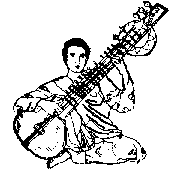


The reason I'm being so hard nosed about this is that until you've heard the sitar being played and you realise how the sound is reproduced; how your fingers work in harmony; and the quality of ornamentations capable on the sitar; only then can you appreciate what's missing from the synth imitations.
The other thing I get a lot is when someone, in attempting to play a sitar patch or really any other instrument like a sax or guitar, will play these twangy and ultra vibrato-ish pulls that they think sound like Indian music..... It sounds horible. I am sorry that's what you think we are playing. But we are not! Listen carefully and you will see that the trills and ornaments are very specific. There is a scale we are working within and the ornate pulls (we call these meends) have to be right on the notes to be effective. If you try to imitate these on other instruments you have to do them right and not just try to "wing it." Such display especially in front of an Indian musician will not only be taken in disgust but your musical credibility will be compromised. There is a definite pattern to the ornamentations. So listen to the fast graces and practice them well before trying to perfom them on any instrument.
I have noticed this behavior more in a musician that thinks he/she has made it in music and frequently their excuse for not "getting it" is that "one has to be born" into the music in order to really "hear it." I am sorry... that I don't agree with. My feeling is that it is all a matter of study and patience.
Now I don't want anyone getting discouraged with these statements. But I am only tring to react to what I'm seeing as a trend and trying to correct it before it becomes a tradition. So practice your chops well. If all else seems confusing, corner an Indian musician and ask them to throw some light on anything you don't understand. I am sure most of them will be happy to help.
- 1. A keyboard, or a fretted Instrument like the Guitar will not reproduce the pitches correctly.
This is a fact. The Western system of tuning has its limitations. Have you ever noticed that no matter how hard you try you just can't get very meditative with a guitar or a piano? Sure, some composers will try to work around this by feeding their music with other non-musical elements to confuse the ear. But as far as a single melodic phrase is concerned and this being played without any rhythm or orchestral accompaniment, the notes will just not has a very peaceful effect.
This problem is due to the Western Equal temperament tuning. This turns every fixed pitched instrument into a 12 tone equal temperament instrument where every half step is 100 cents and thus the whole octave of 12 notes is 1200 cents. Well herein lies the problem!
Music intonation cannot be displayed in such a neat package.
how can some new textures are being The only real way to have accuracy of sitar tone or timbre is through live playing. There is another important issue that many of the sampling and synthesists lack - and that is purity in intonation.
Let me explain what I mean.
Proper Intonation
Other Issues:
1 • 2 • 3 • 4 • 5 • 6 • 7 • 8 • 9
Please Note: All content is copyright ©2003 Ashwin Batish. All rights reserved. Unauthorized copying, photocopying, transmitting this document on hard paper or electronically or by any other means is strictly prohibited and unlawful. You have our permission to link to this page.

CATALOG ARCHIVES RAGANET RAGMALA MIDI PANDIT GURU SHISHYA S.D. BATISH ASHWIN BATISH CONCERTS INSTRUMENTS LINKS CD, DVD DUPS
email: info [at] batish.com copyright ©1995 - 2003 Batish Institute. All rights reserved. Intended For Personal Use Only. No part of the information here may be reproduced or utilized in any form or by any means, electronic or mechanical, including photocopying and recording, or by any information and storage retrieval system, without specific written permission from the Batish family.